Click on images to enlarge
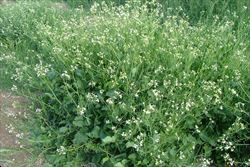
infestation (Photo: Sheldon Navie)
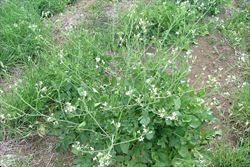
habit (Photo: Sheldon Navie)
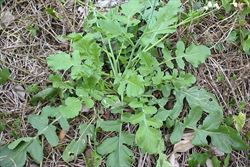
the large and deeply-lobed lower leaves (Photo: Sheldon Navie)
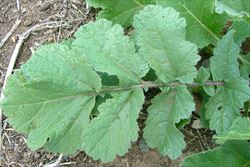
close-up of lower leaf with several deep lobes that have bluntly toothed margins (Photo: Sheldon Navie)
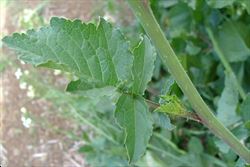
close-up of stem, with scattered stiff hairs, and smaller upper leaf (Photo: Sheldon Navie)
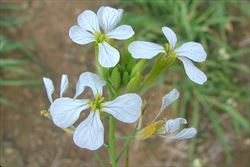
whitish flowers with conspicuous darker veins (Photo: Sheldon Navie)
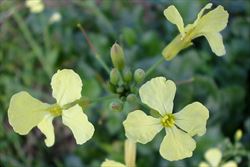
close-up of pale yellow flowers (Photo: Sheldon Navie)
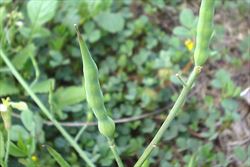
immature fruit (Photo: Sheldon Navie)

mature fruit (Photo: Sheldon Navie)
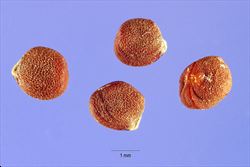
close-up of seeds (Photo: Steve Hurst at USDA PLANTS Database)
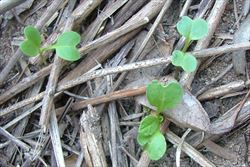
seedlings with heart-shaped cotyledons (Photo: Sheldon Navie)
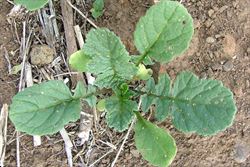
young plant (Photo: Sheldon Navie)
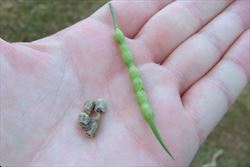
immature fruit with long 'beak' and mature one-seeded segments (Photo: Sheldon Navie)
Scientific Name
Raphanus raphanistrum L.
Synonyms
Raphanus raphanistrum L. subsp. raphanistrum
Family
Brassicaceae (Queensland, New South Wales, the ACT, Victoria, Tasmania, Western Australia and the Northern Territory).Cruciferae (South Australia)
Common Names
cadlock, charlock, jointed charlock, jointed radish, pointed charlock, radish, radish weed, runch, white charlock, wild charlock, wild kale, wild radish, wild rape, wild turnip
Origin
Native to Europe, the Azores, the Madeira Islands, the Canary Islands, northern Africa (i.e. Algeria, Egypt, Libya, Morocco and Tunisia) and western Asia.
Naturalised Distribution
A very widely naturalised species that is most common in the southern and eastern parts of the country. It is very common in south-eastern Queensland, the costal and sub-coastal districts of New South Wales, the ACT, Victoria, Tasmania, south-eastern South Australia and south-western Western Australia. It also has a scattered distribution in other parts of Queensland, New South Wales, South Australia and Western Australia and is possibly also naturalised in the Northern Territory.
Habitat
A weed of disturbed sites, waste areas, roadsides, crops, pastures, waterways, floodplains and open woodlands in temperate, sub-tropical, semi-arid and sometimes also tropical regions.
Habit
An upright (i.e. erect or ascending) and short-lived (i.e. annual or biennial) herbaceous plant usually growing 40-100 cm tall, but occasionally reaching up to 1.5 m in height. It forms a basal rosette of leaves during the early stages of growth.
Distinguishing Features
- an upright herbaceous plant usually growing 40-100 cm tall.
- it forms a basal rosette of large, deeply lobed leaves during the early stages of growth.
- its smaller and narrower upper leaves are alternately arranged and less lobed than the lower leaves.
- its white, pale yellow, lilac, pink or purplish flowers (18-40 mm across) have four petals are borne in loose elongated clusters at the tips of the branches.
- its elongated fruit (3-9 cm long and 3-6 mm wide) are borne on stalks 1-3 cm long and end in a tapering 'beak' (1-3 cm long).
- these fruit break up into several one-seeded segments when mature.
Seedling
The two seed leaves (i.e. cotyledons) are heart-shaped (i.e. cordate) with deeply indented tips (i.e. emarginate apices). They are hairless (i.e. glabrous) and borne on relatively long stalks (i.e. petioles). The first true leaves are bluntly toothed (i.e. crenate) or somewhat lobed with rounded tips (i.e. obtuse apices). They are roughly hairy (i.e. pubescent) with prominent veins.
Stems and Leaves
The stems are rounded or slightly angled and often bluish-green to purplish in colour. They may be unbranched or produce a few long branches near the base of the plant.
The leaves are green or bluish-green in colour, covered with scattered stiff hairs (i.e. they are hispid), and are slightly rough to the touch (i.e. scabrous). Lower leaves (15-30 cm long and 5-10 cm wide) are stalked (i.e. petiolate), deeply lobed (i.e. pinnatisect), and have irregularly toothed (i.e. crenate or serrate) margins. Stem leaves are alternately arranged and the uppermost leaves are smaller (up to 7.5 cm long), narrower, and less lobed or toothed than the lower leaves.
Flowers and Fruit
The flowers (18-40 mm across) are borne on stalks (i.e. pedicels) and are arranged in loose elongated clusters at the tips of the branches (i.e. in terminal racemes). They have four petals (1-2 cm long) with conspicuous veins and may be white, pale yellow, lilac, pink or purplish in colour. Flowering occurs mostly from winter through to early summer.
The elongated fruit resembles a pod (i.e. siliqua) and is slightly to strongly constricted between each of the seeds. These fruit (3-9 cm long and 3-6 mm wide) are borne upright (i.e. semi-erect) or spreading on stalks 1-3 cm long and terminate in a tapering 'beak' (1-3 cm long). They are green or purplish when immature, but turn yellowish-brown or greyish in colour as they mature. When fully mature, they readily break up into 3-10 barrel-shaped segments (3-7 mm long and 2-5 mm wide), each segment containing a single seed. The seeds are egg-shaped (i.e. ovoid) or almost rounded in shape (1.5-4 mm long), with a finely pitted surface, and are reddish or yellowish-brown in colour.
Reproduction and Dispersal
Reproduction in this species is only by seed, which are spread shorter distances by wind, water, animals and human activities. Dispersal via contaminated agricultural produce is thought to be the most significant means of long range spread.
Environmental Impact
While this species is mostly a weed of agricultural areas and habitation, wild radish (Raphanus raphanistrum) is also troublesome in natural vegetation in some areas. It is seen as an environmental weed in Victoria and Western Australia and during a recent survey was listed as a priority environmental weed in two Natural Resource Management regions.
In Victoria, wild radish (Raphanus raphanistrum) is listed as a major environmental weed in Kinglake National Park. It is also present in other conservation areas in this state (e.g. Organ Pipes National Park) and appears on environmental weed lists for Knox City, Boroondara City and the Colac-Otway Shire.
Wild radish (Raphanus raphanistrum) was also recently ranked as a mild environmental weed in the Environmental Weed Strategy for Western Australia. It occasionally grows amongst disturbed natural vegetation in this state, including in mallee, salmon gum, and York gum woodlands.
Though wild radish (Raphanus raphanistrum) has not often been seen as an environmental weed in other parts of Australia, it certainly occupies natural habitats in other states. It has been recorded in several conservation areas in South Australia (e.g. Onkaparinga River National Park, Belair National Park, Deep Creek Conservation Park, Kyeema Conservation Park, Horsnell Gully Conservation Park and Sturt Gorge Recreation Park) and in Kinchega National Park in south-western New South Wales. It is also a common weed of riparian vegetation around Brisbane in south-eastern Queensland.
Other Impacts
Wild radish (Raphanus raphanistrum) is a major weed of winter crops in southern and eastern Australia, and is particularly troublesome in cereal and brassica crops. It is also thought to be poisonous to livestock.
Legislation
This species is declared under legislation in the following states and territories:
- New South Wales: Class 4 - a locally controlled weed. The growth and spread of this species must be controlled according to the measures specified in a management plan published by the local control authority and the plant may not be sold, propagated or knowingly distributed (in a minority of local authority areas). See the New South Wales Department of Primary Industries Noxious Weeds List at http://www.dpi.nsw.gov.au for more detailed information on which local areas are covered in these declarations.
- Western Australia: Unassessed - this species is declared in other states or territories and are prohibited until assessed via a weed risk assessment (throughout the entire state).
Management
For information on the management of this species see the following resources:
- Moore and Wheeler (2002), Southern Weeds and their Control, pp. 42-47.
Similar Species
Wild radish (Raphanus raphanistrum) may be confused with numerous closely related weedy plants (e.g. Diplotaxis spp., Brassica spp., Sinapis spp., Sisymbrium spp., Rapistrum rugosum, Hirschfeldia incana and Myagrum perfoliatum). However, the fruit of these species are usually less then 3 mm wide and split open when mature, instead of breaking up into one-seeded segments.
It can also be distinguished from two less common naturalised radishes (i.e. Raphanus maritimus and Raphanus sativus) by the following differences:
- wild radish (Raphanus raphanistrum) fruit are relatively long (3-9 cm long) and slender (3-5 mm wide). They are constricted between the seeds and break up into one-seeded segments when mature.
- sea radish (Raphanus maritimus) fruit are relatively small (2-6 cm long) and thick (5-8 mm wide). They are constricted between the seeds and break up into one-seeded segments when mature.
- garden radish (Raphanus sativus) fruit are relatively short (2-6 cm long) and thick (5-10 mm wide). They are not constricted between the seeds and do not break up into one-seeded segments when mature.

